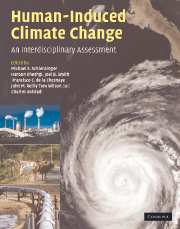Book contents
- Frontmatter
- Contents
- List of contributors
- Preface
- Part I Climate system science
- Part II Impacts and adaptation
- Part III Mitigation of greenhouse gases
- Part IV Policy design and decisionmaking under uncertainty
- 25 Climate policy design under uncertainty
- 26 Climate policy assessment using the Asia–Pacific Integrated Model
- 27 Price, quantity, and technology strategies for climate change policy
- 28 What is the economic value of information about climate thresholds?
- 29 Boiled frogs and path dependency in climate policy decisions
- 30 Article 2 and long-term climate stabilization: methods and models for decisionmaking under uncertainty
- 31 Whither integrated assessment? Reflections from the leading edge
- 32 Moving beyond concentrations: the challenge of limiting temperature change
- 33 International climate policy: approaches to policies and measures, and international coordination and cooperation
- Index
- Plate section
- References
26 - Climate policy assessment using the Asia–Pacific Integrated Model
from Part IV - Policy design and decisionmaking under uncertainty
Published online by Cambridge University Press: 06 December 2010
- Frontmatter
- Contents
- List of contributors
- Preface
- Part I Climate system science
- Part II Impacts and adaptation
- Part III Mitigation of greenhouse gases
- Part IV Policy design and decisionmaking under uncertainty
- 25 Climate policy design under uncertainty
- 26 Climate policy assessment using the Asia–Pacific Integrated Model
- 27 Price, quantity, and technology strategies for climate change policy
- 28 What is the economic value of information about climate thresholds?
- 29 Boiled frogs and path dependency in climate policy decisions
- 30 Article 2 and long-term climate stabilization: methods and models for decisionmaking under uncertainty
- 31 Whither integrated assessment? Reflections from the leading edge
- 32 Moving beyond concentrations: the challenge of limiting temperature change
- 33 International climate policy: approaches to policies and measures, and international coordination and cooperation
- Index
- Plate section
- References
Summary
Introduction
It is predicted that global climate change will have significant impacts on the society and economy of the Asia–Pacific region, and that the adoption of measures to tackle global climate change will impose a large economic burden on the region. Also, if the Asia–Pacific region fails to adopt such countermeasures, it has been estimated that its emissions of greenhouse gases (GHG) will increase to over 50% of total global emissions by 2100. To respond to such a serious and long-term threat, it is critical to establish communication and evaluation tools for policymakers and scientists in the region. The Integrated Assessment Model provides a convenient framework for combining knowledge from a wide range of disciplines, and is one of the most effective tools to increase the interaction among groups.
The Asia–Pacific Integrated Model (AIM) is one of the most frequently used models in the Asia–Pacific region (Kainuma et al., 2003; Shukla et al., 2004). The distinctive features of AIM are: (1) it involves Asian country teams from Japan, China, India, Korea, Thailand, and so on; (2) it has detailed description of technologies; and (3) it uses information from a detailed geographic information system to evaluate and present the distribution of impacts at local and global levels. Besides preparing country models for evaluation at the state and national level, we have also developed global models to analyze international economic relationships and climate impacts in order to evaluate policy options from a global viewpoint.
- Type
- Chapter
- Information
- Human-Induced Climate ChangeAn Interdisciplinary Assessment, pp. 314 - 327Publisher: Cambridge University PressPrint publication year: 2007
References
- 1
- Cited by



